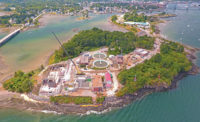The Town of Georgetown, Colo., dedicated its newly expanded wastewater treatment facilities on June 21. The improvements replaced and upgraded the existing aging wastewater treatment facility equipment and processes, most of which incorporate sustainable attributes.


The project also expanded the facility’s capacity by almost 40% and greatly improves the quality of water in Clear Creek, a key Colorado artery that provides recreation and water supply to downstream agricultural and drinking water users.
New features include an upgrade of the existing conventional activated sludge process equipment with an integrated fixed film activated sludge process, which provides advanced biological nutrient removal treatment; a retrofit of the existing aeration basin into a new, larger secondary clarifier to replace the existing secondary clarifier; retrofit of an existing clarifier into effluent equalization, continuous upflow sand filtration for enhanced solids, phosphorus and zinc reduction; construction of new biosolids storage tanks; and the addition of septage receiving facilities. The treatment facility employs sustainable solutions to protect public health and environmental resources well into the future.
John Curtis, Georgetown Water and Wastewater superintendent, and his operations staff aptly managed the barely functional facility, originally constructed in 1967. But it was beginning to fail, and Curtis knew they would face a significant financial challenge to upgrade and replace it.
At the same time, the town’s water treatment plant, originally installed in 1964, was in similar condition. The Colorado Dept. of Public Health and Environment (CDPHE) no longer recommended treatment technology in use as of 2005.
Committed to finding crucial funding resources, Georgetown and engineering consultant Frachetti Engineering Inc. looked for ways to fund the infrastructure upgrades. Financial assistance from the Colorado Dept. of Local Affairs in the form of matching grants allowed the team to move forward with planning and preliminary engineering.
During the planning stage, the 2009 American Recovery and Reinvestment Act was signed into law, and as a part of ARRA, the two CDPHE State Revolving Loan Funds received approximately $60 million of capitalization grants for water and wastewater infrastructure projects.




